Female Enlightened Manifestations and Female Teachers and Lamas — Wisdom in Action; Reader Poll and Interview with Lama Shannon Young
“If being a woman is an inspiration, use it. If it is an obstacle, try not to be bothered by it.” — Jetsun Khandro Rinpoche.
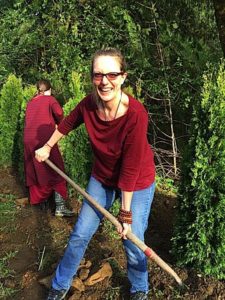
“I feel that there could always be more female Buddhist role models and teachers,” said Lama Acharya Dr. Shannon Young when we asked her to comment on a Buddha Weekly poll that indicated 92.3 percent of respondents felt there were not enough female teachers. She added, “I am grateful for the strong women who have been the trailblazers in the western adoption of Buddhism, but I would like to see more women in leadership positions in traditionally Buddhist countries as well.” [FULL Interview with Lama Shannon Young inset below.]
One such trailblazer, Jetsunma Tenzin Palmo (Diane Perry) took Female Buddha Tara’s vow as her own: “I took the vow to attain enlightenment in a female body.” [5] She adds, “Even Tibetan masters are beginning to realize, if you want real devotion and focus, you have to look to the nuns.”
Does Buddhism Really Embrace the Female Divine?
Mahayana Buddhism embraces the Female Enlightened Manifestation (Is F.E.M. too cute an acronym?). Most Mahayana Buddhists revere Female Enlightened Manifestations — Guan Yin, Tara, Vajrayogini, Palden Lhamo, Yeshe Tsogyal, and many other aspects of divine wisdom. It’s safe to say Enlightened Goddess Tara became the most popular of these, in part because of her resounding promise to “always be born as a woman” and in part because she, like a mother, would do anything to protect her children. [4] (For more on Tara as the rescuer, and her activities in modern life, see this earlier BW feature>>)
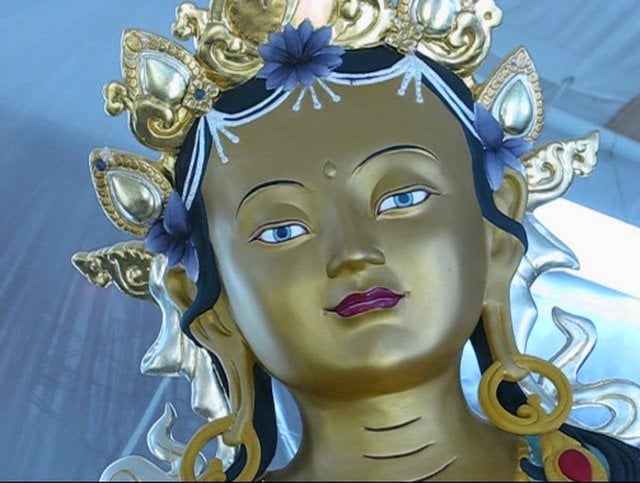
“Lord Buddha had prophesied that Arya Tara would manifest as a woman and would benefit living beings in this form,” explained Venerable Choje Lama Phunstock. “Actually, there is no difference between men and women, but there are less manifestations of women who engage in Bodhisattva activities than men.”
Venerable Phunstock may be right — there do seem to be correspondingly fewer women teachers. But, is this changing for the better? We decided to ask these questions of students (internet poll, results in this feature) and also the teachers — including an interview with Lama Archarya Dr. Shannon Young (Biography at end of feature). [Watch for a full teacher profile interview of Lama Dr. Young in February..]
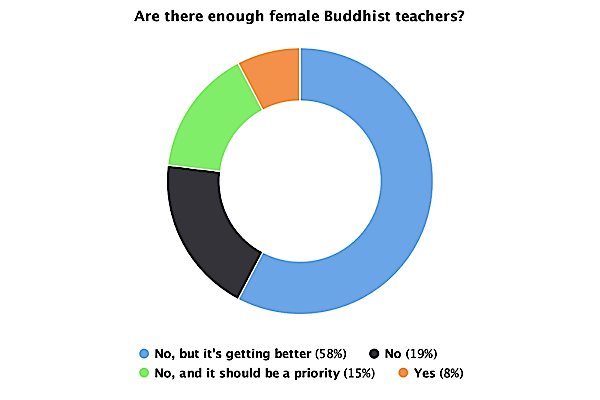
Poll: 92.3 percent Say Not Enough Female Teachers
In a survey conducted by Buddha Weekly (February 2017, see note below), 88 percent of respondents said they practice a female Buddha, Bodhisattva or Yidam, while — amongst the same respondents — 92.3 percent indicated that there weren’t enough female teachers. To be fair, 57.7 percent voted “No, but it’s getting better” — but it still begs the question: in Mahayana Buddhism, whose practitioners honor the Enlightened Feminine so overwhelmingly, why are there not enough female teachers? Or are there?

When we asked Lama Dr. Shannon Young (of the Dzogchen lineage) this question, she diplomatically answered:
“I think it does matter to have the diversity of leadership in today’s world. This is why I am very proud that four of the eight lamas that I was authorized with are women. Two of us are from the US and the other two are from Asia.”
Sangye Khandro, a well known teacher in Vajrayana Buddhism, supports this view. She said, “The notion that Vajrayana is male-oriented is mistaken.” [1]

Long List of Great Female Teachers
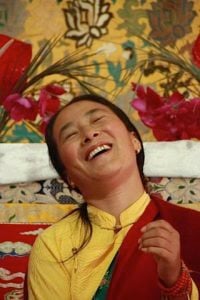
This seems to be confirmed by the long list list of famous female Buddhist teachers practicing today. According to one respondent to our poll, among the most famous female teachers are:
“Pema Chödrön, Jetsunma Tenzin Palmo, Ven. Thubten Chödron, Sangye Khandro, Lama Yeshe Dechen Wangmo, Ven. Robina Courtin, Judith Lief, Jan Bays, Chozen Roshi, Joan Halifax, Roshi Joko Beck, Pat O’Hara, Enkyo Roshi, Wendy Nakao, Roshi Geri Larkin, and many, many more whose faces I can see but whose names I can’t recall.”
Historically, perhaps the most famous female teacher was Machik Labdron, who founded an entire lineage based on precious Chod practices.
21 Taras Praise in Sanskrit is a wonderful way to honor Tara, Mother of all the Buddhas:
Today’s dynamic and precious teachers, such as Pema Chodron certainly represent great role models who embody the “wisdom” of the Female Enlightened. Just a quick look at her book titles provokes a deep thought, titles such as When Things Fall Apart, Start Where We Are, and Places that Scare You.
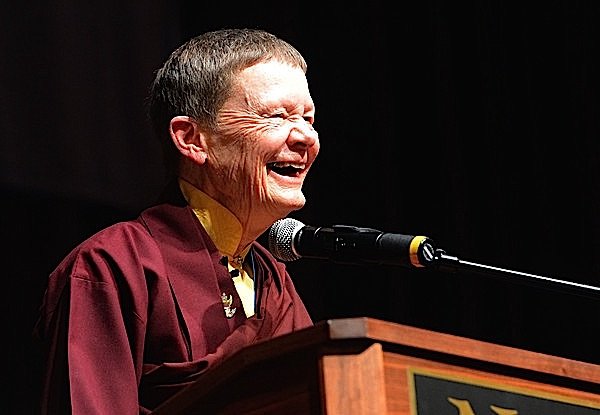
In When Things Fall Apart she provokes the vastness of the wisdom voyage with:
“Embarking on the spiritual journey is like getting into a very small boat and setting out on the ocean to search for unknown lands.”
Scary stuff? Maybe. But it speaks to the depth of Buddhist Wisdom. It also evokes the “scary” wisdom of the wild Enlightened Dakini, iconic of the Divine Feminine in Buddhism.
Video of Pema Chodron: The Importance of Teachers:
Indeed, we do have many well-known, wise, and wonderful female teachers. Lama Shannon Young said that her teacher actively encouraged her to become a teacher:
“My teacher is Dzogchen Khenpo Choga Rinpoche. He sincerely believes that the best way you can benefit beings is by teaching them the Dharma and he believes that people of different cultures should be taught by members of their own culture. From my first teachings with him, he was always encouraging every student to aspire to become a teacher.”
Poll: 88 percent Practice Female Manifestations
In Mahayana equal emphasis is placed on male and female aspects — representing compassion and wisdom, respectively. Both are vital and equal on the journey to Enlightened mind. Classically, Compassion is represented by Male manifestations (especially Chenrezig or Avalokiteshvara), while Wisdom (understanding Emptiness) is symbolized in the Feminine (especially Tara or Prajnaparamita or the elusive Enlightened Dakini).

Lama Dr. Shannon Young puts it this way:
“Female manifestations are important as they help transform a practitioners’ mind from narrow, ego-centric notions of self and identity to something more inclusive and powerful. We can then begin to realize our innate love, compassion, and wisdom.”
It would not be incorrect to say that practice is incomplete without both compassion and wisdom, male and female manifestations. In advanced practices, the manifestations are often visualized as consorts (both in union) to symbolize this profound truth — and both equally important.
One way to celebrate International Women’s Day and Women’s History Month is to practice glorious Mother Tara. A good start is to recite her Sutra:
Tara and the “A List” Female Enlightened Manifestations
Before diving into the big topic of female teachers in Buddhism, it’s useful to point to those shining examples of Wisdom in female form. The Female Buddhas are “A list” manifestations, not supporting consorts.
“If Bodhicitta is the basis of both the Mahayana and Vajrayana path then the basis of cultivating Bodhicitta is remembering the kindness of a mother,” explains Lama Dr. Shannon Young. “Invoking the blessings, love, and compassion of Tara, being the great Mother, is essential as support for increasing one’s own intention of enlightened wisdom, which is Bodhicitta.”
For these reasons, Tara is called the Mother of All Buddhas. The same can be said of Prajnaparamita, Vajrayogini, and other Female Enlightened Manifestations. Since Wisdom realizing emptiness must be embraced to reach the lofty goal of Enlightenment, it can be said that the female manifestations, representing wisdom, are the Mothers of all the Buddhas and Bodhiasattvas. (For more on this, see this previous extensive feature on Tara>>)
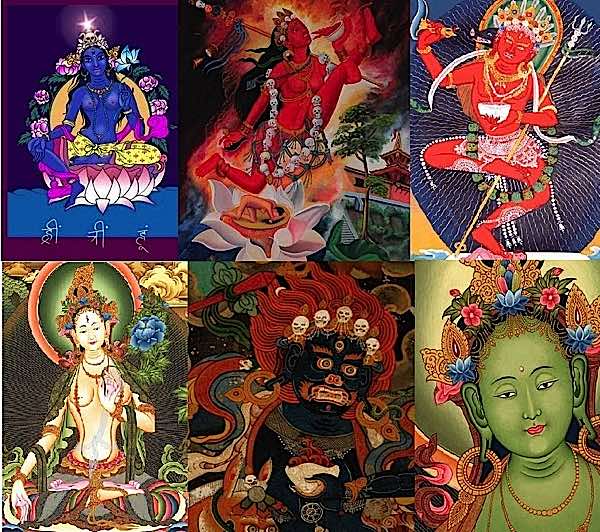
How important are the Female Enlightened Manifestations? “Arya Tara was the main Yidam of the great past sages and saints Nagarjuna, Atisha, and Chandragomin,” writes Venerable Lama Phunstock. “She was also one of the main Yidams of many most renowned Tibetan Lamas, specifically of the First Gyalwa Karmapa, Düsum Khyenpa, who had five Yidams that accorded with the five aspects of enlightened activity. Arya Tara represents the aspect of speech and the elimination of obstacles. The First Karmapa’s other Yidams were Vajrayogini, Chakrasamvara, Gyalwa Gyatso who is Red Chenrezig, and Hayagriva. If we whole-heartedly supplicate Arya Tara and ask her to help us overcome our problems, then we will succeed and, until solved completely, our problems will not affect us as strongly.” Of the First Karmapa’s meditational deities, two of the most important were female — Tara and Vajrayogini.

“From my heart I bow to Divine Mother Tara, essence of love and compassion, the most precious objects of refuge gathered into one. From now until I reach enlightenment, hook me with your great love and kindness to liberate me.”
Lama Shannon Young punctuates the importance of all forms of the Enlightened: “Boundless love, compassion, and wisdom will always manifest in various forms in order to benefit beings.”
Mahayana and Vajrayana are Not Male Oriented?
If you equate gender equality to the importance of female Enlightened Buddhas and Yidams, you would have to conclude Mahayana and Vajrayana Buddhism are unbiased and inclusive. Without question, the majority of Vajrayana and Mahayana Buddhists practice a Female Buddha — 88 percent in our poll — most notably beloved Mother Tara or Guan Yin, and for Highest Yoga Tantra practices, Vajrayogini or Vajravarahi, Palden Lhamo and others.
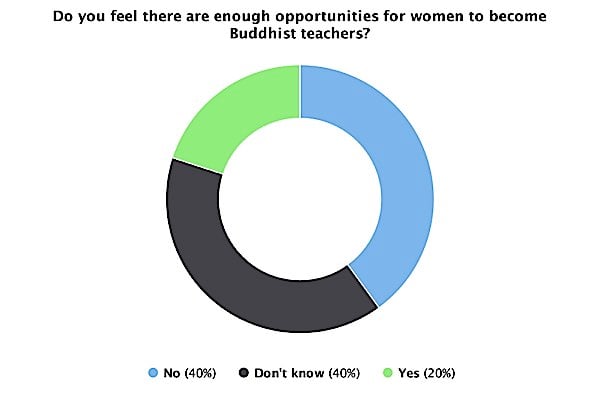
So, is Buddhism sexist? A search online reveals many opinions that seem to affirm that label. Yet, it seems unlikely in the context of Shakyamuni Buddha’s trail-blazing, and the vast array of Female Enlightened Manifestations practiced.
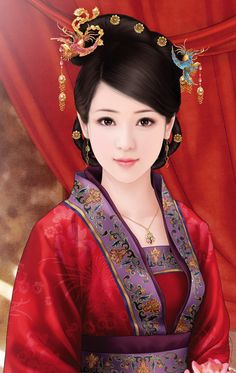
Shakyamuni Buddha “was the first religious Teacher who gave religious freedom to women,” writes Venerable K. Shri Dhammananda Maha Thera. “Before the Buddha… women were not even allowed to enter any temple or recite any religious scripture.”
Shakyamauni Buddha was also born as a woman many times in past lives according to the Jakarta Tales. Venerable Thera writes: “The Buddha Himself was born as a woman on several occasions during His previous births in Samsara.”
“I disagree with blaming sexism on Tibetan Buddhism,” said well-known teacher Sangye Khandro. “During my years among Tibetans, I have not been disadvantaged on account of being female — just the opposite. From the very beginning, I was given every opportunity to learn, sometimes even more so than men!”
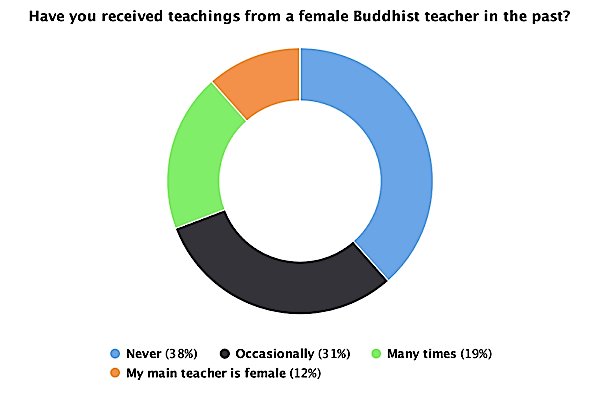
In our February 2017 poll, only 12 percent indicated their main teacher was female, while 31 percent received teachings from female teachers occasionally, and 19 percent received teachings “many times”. Only 3.8 percent said the “never” received teachings from a female teacher. This does support accessibility of teachings from female teachers.
Enough Female Teachers in Buddhism?
Sangye Khandro spoke about sexism: “Your question about sexism makes me think of a visit I made to Larung Gar, Eastern Tibet, where there is a large, thriving practice community I certainly didn’t see any patriarchal Buddhism there. It has more Khenmos [female abbots] than Khenpos [male abbots]. The female practitioners run the show. The head lama for those tens of thousands of practitioners is Khandro-ma Ani Mumtso, a nun. She’s the one who gives the empowerments for all the transmissions. No one has a problem with that. It’s a given that women can teach men there.”
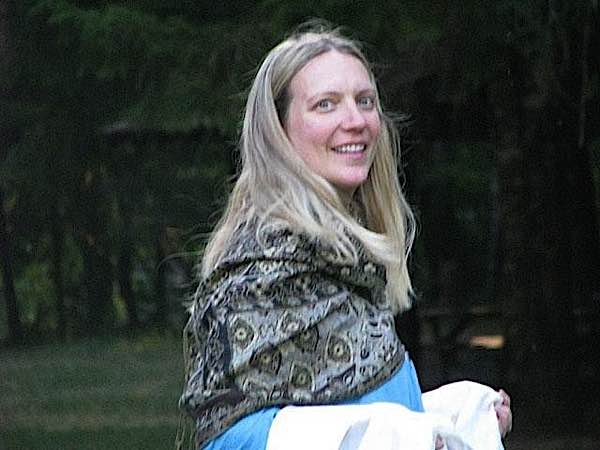
In our poll we didn’t ask about sexism, and it was clear there were a lot of teaching opportunities with female lamas. What was equally clear was that the majority of respondents practice Female Enlightened Buddhas. An overwhelming 88 percent said they practice Female Buddhas regularly, and only 8 percent said they did not. (Four percent indicated they’d rather not say).
Full Interview with Lama Dr. Shannon Young
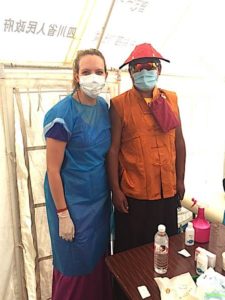
BW: From your perspective as a teacher, are there enough female Buddhist teachers? Does it matter? Why?
I feel that there could always be more female Buddhist role models and teachers. I am grateful for the strong women who have been the trailblazers in the western adoption of Buddhism, but I would like to see more women in leadership positions in traditionally Buddhist countries as well. I think it does matter to have the diversity of leadership in today’s world. This is why I am very proud that four of the eight lamas that I was authorized with are women. Two of us are from the US and the other two are from Asia.
BW: What inspired you to become a teacher?
My teacher is Dzogchen Khenpo Choga Rinpoche. He sincerely believes that the best way you can benefit beings is by teaching them the Dharma and he believes that people of different cultures should be taught by members of their own culture. From my first teachings with him, he was always encouraging every student to aspire to become a teacher.
BW: Do you feel there are enough opportunities for women to become Buddhist teachers? If not, what can be done about it?
I definitely think there could be more, but I also think it depends on the lineage or program. Candidly I think that in my lineage there are plenty of opportunities. But I think in the public sphere, the notion of female Buddhist teachers and Lamas needs to be more widely embraced. Especially in terms of authority.
BW: What do the female Enlightened Deities represent?
Boundless love, compassion, and wisdom will always manifest in various forms in order to benefit beings.
BW: Why are Female manifestations important?
Female manifestations are important as they help transform a practitioners’ mind from narrow, ego-centric notions of self and identity to something more inclusive and powerful. We can then begin to realize our innate love, compassion, and wisdom.
BW: Tara is iconic of the Female Enlightened. What does She represent?
If Bodhicitta is the basis of both the Mahayana and Vajrayana path then the basis of cultivating Bodhicitta is remembering the kindness of a mother. Invoking the blessings, love, and compassion of Tara, being the great Mother, is essential as support for increasing one’s own intention of enlightened wisdom, which is Bodhicitta.
Lama Biography — Venerable Archarya Lama Shiwa Dr. Shannon Young
Venerable Archarya Lama Shiwa, Dr. Shannon Young, Pema Shiwa Tso, is an authorized Lama and Dharma Teacher in the Dzogchen Lineage of Buddhism. Shannon received her Doctor of Pharmacy degree in 2001 and has been a practicing Pharmacist for over 16 years. She first studied with her root teacher His Eminence Dzogchen Khenpo Choga Rinpoche in 2003 and for over 13 years has studied and practiced with Rinpoche while helping establish the Dzogchen Retreat Center, USA. and the Dzogchen Shri Singha Foundation.
Lama Shannon graduated from seven Dzogchen Lineage Internships along with many seasonal retreats. In 2014, Lama Shannon also received an advanced degree of Tantra Practitioner at the first Dzogchen Lineage Internship commencement ceremony at the Dzogchen Retreat Center USA. In the same year, Dzogchen Khenpo Choga Rinpoche authorized Lama Shannon, along with eight other Lamas, as a Venerable Archarya Lama. The Lamas were selected through a dynamic process of divination, prayer, Rinpoche’s 10-year evaluation, and a majority vote of the 2014 Dzogchen Lineage Internship Sangha.

Lama Shannon has taught many students in public teaching events, weekend workshops, and tutoring during Dzogchen Lineage Internships. Following her teacher’s aspirations, Lama Shannon has dedicated her life to practicing and teaching the Dharma, serving as a Director on the the Board of the Dzogchen Shri Singha Foundation, and recently, founding One Path Outreach, a humanitarian aid organization which just completed their second medical mission in remote villages of Tibet.
Lama Shannon a devoted wife and mother who also helped establish the Dzogchen Children’s Association which supports Dzogchen Sangha parents to integrate a modern daily life that is centered on teaching Dharma and engaging in Dharma activities. Lama Shannon aspires to continue to fulfill her teacher’s aspirations to teach and heal others while establishing a stable Dharma system throughout the world that benefits all beings.
About the Buddha Weekly Poll
The Buddha Weekly poll consisted of four questions and was an unscientific internet poll kept live for one week in February 2017. Although the response rate was high, the nature of the questions and the media would not be considered as accurate as blind polls from marketing companies. Never-the-less, the results are reasonable and likely reflect the broader opinions of Mahayana Buddhists. Do you disagree? Comment below.
NOTE
[1] Dakini Power page on Sangye Khandro
[2] Tantra in the West, Tricycle article, interviewing Sangye Khandro
[3] Buddhism and Women, by Venerable K. Sri Dhammananda Maha Thera
[4] Noble Green Tara, Venerable Choje Lama Phunstock
[5] Ten Tibetan Buddhist Women You Need to Know, Elephant Journal
5 thoughts on “Female Enlightened Manifestations and Female Teachers and Lamas — Wisdom in Action; Reader Poll and Interview with Lama Shannon Young”
Leave a Comment
More articles by this author
Search
Latest Features
Please support the "Spread the Dharma" mission as one of our heroic Dharma Supporting Members, or with a one-time donation.
Please Help Support the “Spread the Dharma” Mission!

Be a part of the noble mission as a supporting member or a patron, or a volunteer contributor of content.
The power of Dharma to help sentient beings, in part, lies in ensuring access to Buddha’s precious Dharma — the mission of Buddha Weekly. We can’t do it without you!
A non-profit association since 2007, Buddha Weekly published many feature articles, videos, and, podcasts. Please consider supporting the mission to preserve and “Spread the Dharma." Your support as either a patron or a supporting member helps defray the high costs of producing quality Dharma content. Thank you! Learn more here, or become one of our super karma heroes on Patreon.
Lee Kane
Author | Buddha Weekly
Lee Kane is the editor of Buddha Weekly, since 2007. His main focuses as a writer are mindfulness techniques, meditation, Dharma and Sutra commentaries, Buddhist practices, international perspectives and traditions, Vajrayana, Mahayana, Zen. He also covers various events.
Lee also contributes as a writer to various other online magazines and blogs.




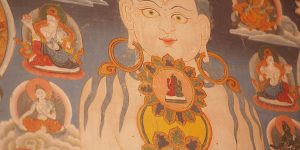














Thank you for exposing the truth about the inclusiveness and power of women in Buddhism. This was an excellent and informative article.
Thank you. In kindness, Lee
I’d also like to see more Ethnic minority teachers too.
what about buddhist special animals as guides ?
is there a stable buddhist animal shrine worldwide ?
Hi Suzanne. Not sure what you are asking? There’s a famous story of Maitreya manifesting as maggot-ridden dog. The great Indian pandit Asanga did retreat for many, many years to achieve Maitreya Buddha, to be able to see Maitreya Buddha, but didn’t see Maitreya Buddha in the hermitage during the retreat, even after doing twelve years didn’t see there. One day he saw a wounded dog in agony with maggots infesting his wound. Great Asanga gently removed the maggots with his own mouth. Then, he realized the maggots would starve, so he cut his own flesh to feed them. When he took this compassionate action, the dog transformed into the Maitreya Buddha he was searching for. (This illustrates not only Emptiness Doctrine, but also the skillfulness of deity forms.)
In Mahayana Buddhism, a core teaching is Emptiness (or Oneness). Also, every being, including animals have Buddha Nature. In Vajrayana the goal is to see past conventional appearances, and that includes our notion of “human” appearance. For all of these reasons, Enlightened Beings can manifest in any form. Ultimately, “Emptiness is Form, Form is Emptiness” (Heart Sutra). There are shrines dedicated to Hayagriva — a manifestation of Chenrezig and Amitabha with horse head emerging from a human head. Likewise, with Vajravarahi (who’s name sometimes means “sow’s head”) who has a female pig emerging from her head. You have Enlightened versions of Ganesha (elephant head), and many others. Form is literally “empty.” In other words, sure, there are many Enlightened beings with animal attributes. I don’t think it’s what you mean — it sounds more like you’re referring to guides and totems. In Buddhism, we take refuge in the Three Jewels: Buddha Dharma and Sangha … however, Enlightened Beings appear in any form that skillfully conveys what we need — just as Maitreya Buddha demonstrated. In kindness, Lee